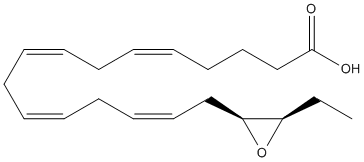17,18-EEQ
General
Type : Epoxy-fatty-acid || Fatty acid
Chemical_Nomenclature : (5Z,8Z,11Z,14Z)-16-[(2R,3S)-3-ethyloxiran-2-yl]hexadeca-5,8,11,14-tetraenoic acid, (5Z,8Z,11Z,14Z)-16-[(2S,3R)-3-ethyloxiran-2-yl]hexadeca-5,8,11,14-tetraenoic acid
Canonical SMILES : CCC1C(O1)CC=CCC=CCC=CCC=CCCCC(=O)O
InChI : InChI=1S\/C20H30O3\/c1-2-18-19(23-18)16-14-12-10-8-6-4-3-5-7-9-11-13-15-17-20(21)22\/h3,5-6,8-9,11-12,14,18-19H,2,4,7,10,13,15-17H2,1H3,(H,21,22)\/b5-3-,8-6-,11-9-,14-12-\/t18-,19+\/m0\/s1 || InChI=1S\/C20H30O3\/c1-2-18-19(23-18)16-14-12-10-8-6-4-3-5-7-9-11-13-15-17-20(21)22\/h3,5-6,8-9,11-12,14,18-19H,2,4,7,10,13,15-17H2,1H3,(H,21,22)\/b5-3-,8-6-,11-9-,14-12-\/t18-,19+\/m1\/s1
InChIKey : GPQVVJQEBXAKBJ-VDTDYMMTSA-N || GPQVVJQEBXAKBJ-YQLHGUCYSA-N
Other name(s) : 17,18-Epoxyeicosatetraenoic acid, 17R,18S-EpETE, 17(R),18(S)-EETeTr, CHEBI:76953, (5Z,8Z,11Z,14Z)-(17R,18S)-17,18-Epoxyicosa-5,8,11,14-tetraenoic acid, 17R,18S-epoxy-5Z,8Z,11Z,14Z-eicosatetraenoic acid, CHEMBL1802675, (+\/-)17(18)-EpETE, 17(S),18(R)-EETeTr, CHEBI:76955, 17,18-EETeTr, 17(18)-epoxy-5Z,8Z,11Z,14Z-eicosatetraenoic acid, CHEMBL1802676
MW : 318.4
Formula : C20H30O3
CAS_number :
PubChem :
UniChem :
Iuphar :

Target
Families : Epoxide_hydrolase
References (2)
| Title : Differential Effects of 17,18-EEQ and 19,20-EDP Combined with Soluble Epoxide Hydrolase Inhibitor t-TUCB on Diet-Induced Obesity in Mice - Yang_2021_Int.J.Mol.Sci_22_ |
| Author(s) : Yang Y , Xu X , Wu H , Yang J , Chen J , Morisseau C , Hammock BD , Bettaieb A , Zhao L |
| Ref : Int J Mol Sci , 22 : , 2021 |
| Abstract : Yang_2021_Int.J.Mol.Sci_22_ |
| ESTHER : Yang_2021_Int.J.Mol.Sci_22_ |
| PubMedSearch : Yang_2021_Int.J.Mol.Sci_22_ |
| PubMedID: 34361032 |
| Title : Epoxy Fatty Acids Are Promising Targets for Treatment of Pain, Cardiovascular Disease and Other Indications Characterized by Mitochondrial Dysfunction, Endoplasmic Stress and Inflammation - McReynolds_2020_Adv.Exp.Med.Biol_1274_71 |
| Author(s) : McReynolds C , Morisseau C , Wagner K , Hammock B |
| Ref : Advances in Experimental Medicine & Biology , 1274 :71 , 2020 |
| Abstract : McReynolds_2020_Adv.Exp.Med.Biol_1274_71 |
| ESTHER : McReynolds_2020_Adv.Exp.Med.Biol_1274_71 |
| PubMedSearch : McReynolds_2020_Adv.Exp.Med.Biol_1274_71 |
| PubMedID: 32894508 |